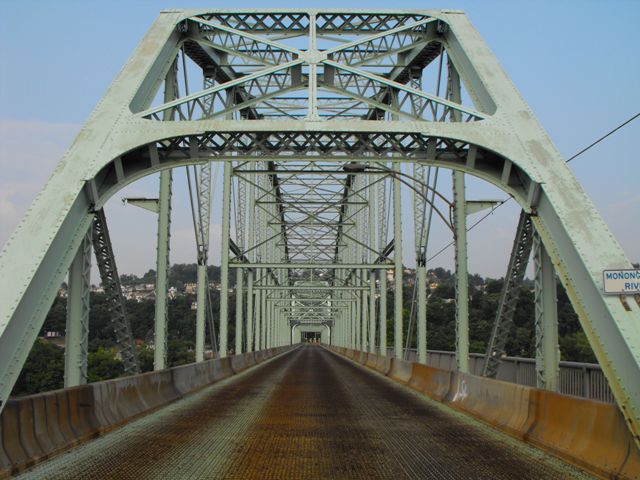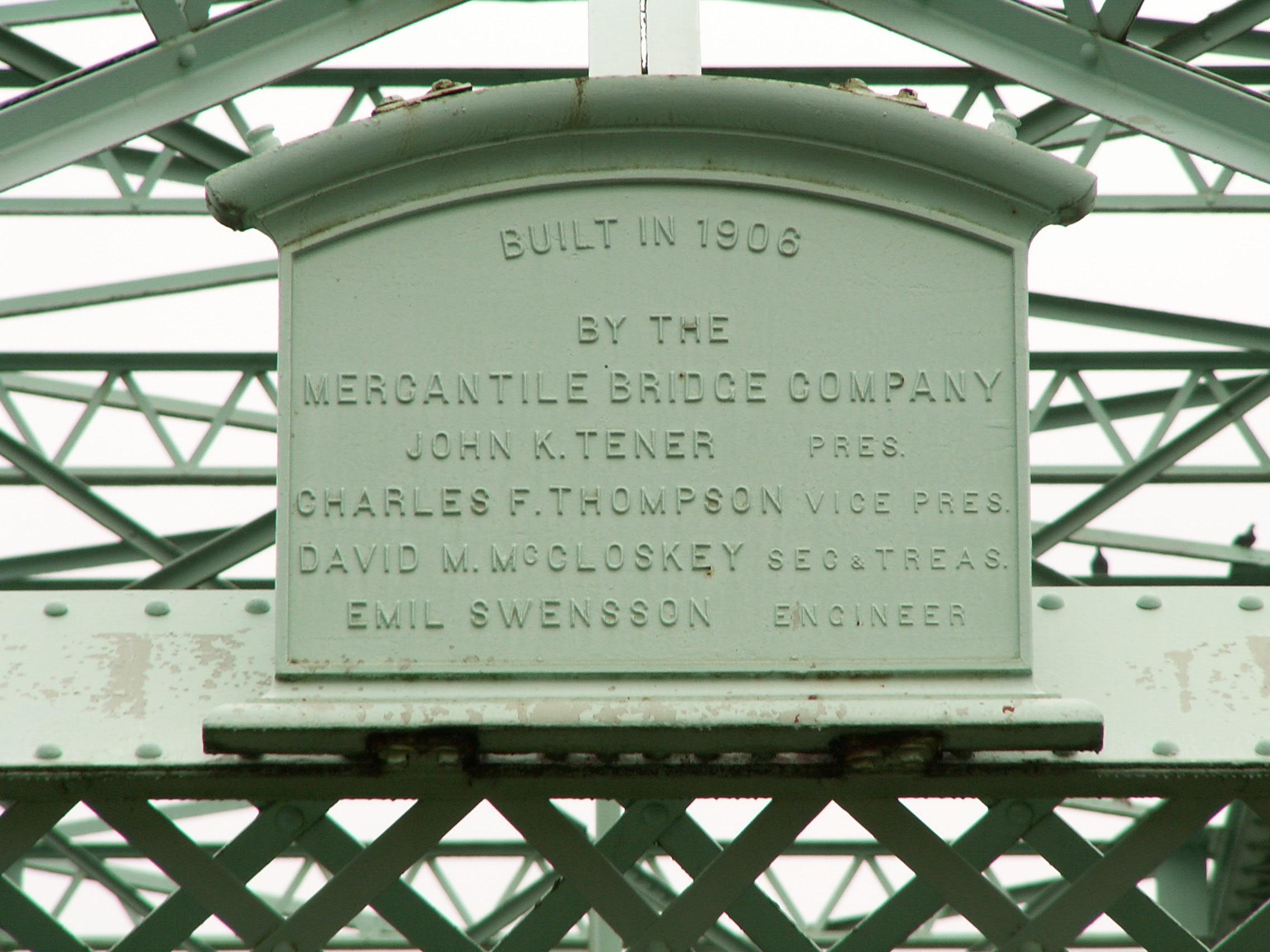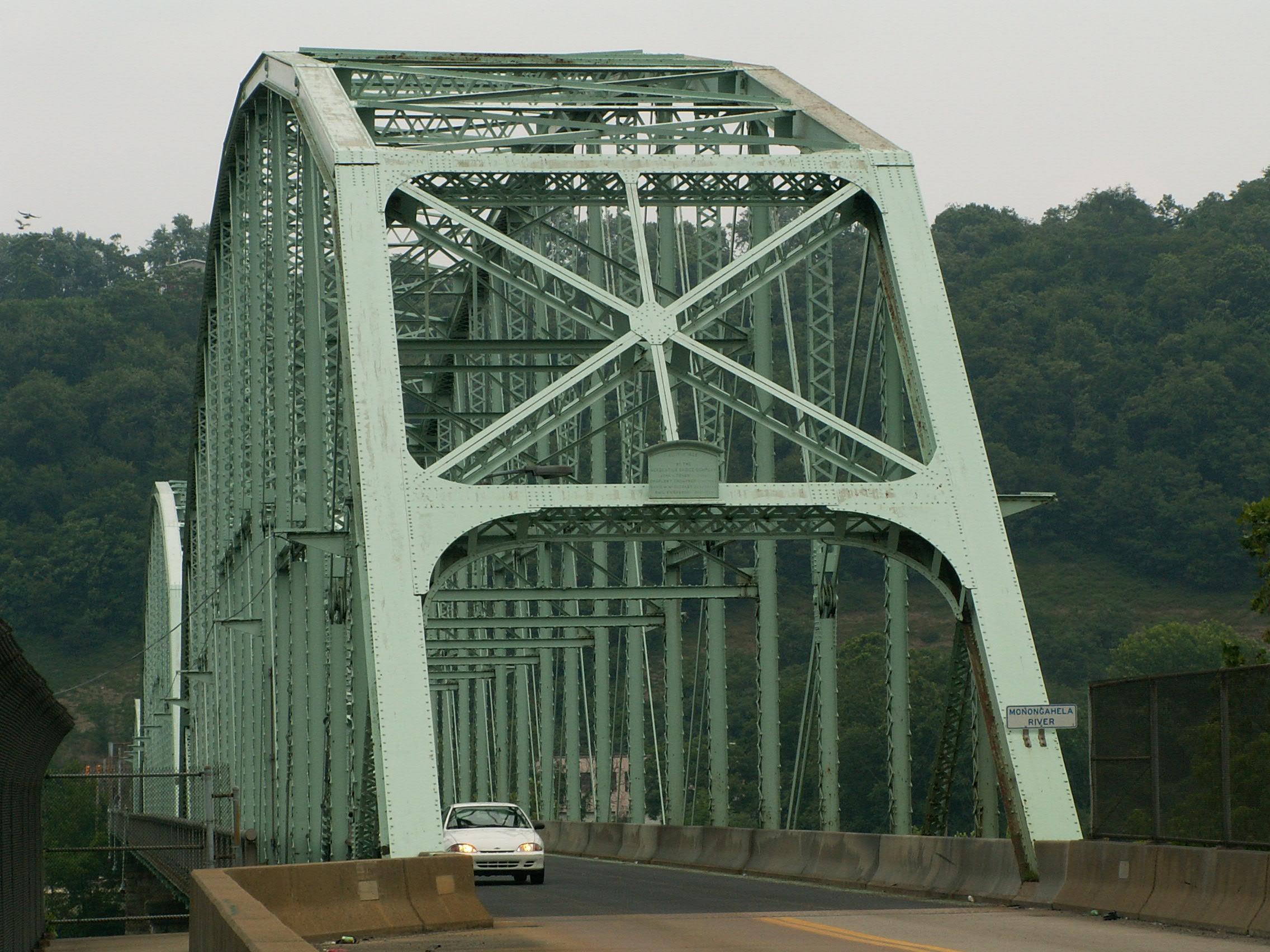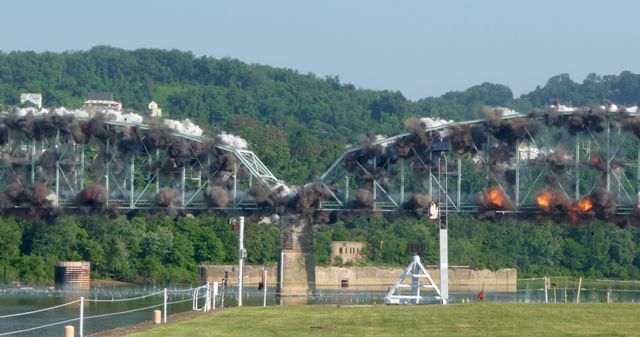We Recommend:
Bach Steel - Experts at historic truss bridge restoration.
BridgeHunter.com Phase 1 is released to the public! - Visit Now
Charleroi-Monessen Bridge

Primary Photographer(s): Nathan Holth and Rick McOmber
Bridge Documented: July 11, 2009 and August 20, 2010
Charleroi and Monessen: Washington County, Pennsylvania and Westmoreland County, Pennsylvania: United States
1906 By Builder/Contractor: American Bridge Company of New York, New York and Engineer/Design: Emil Swensson, of Mercantile Bridge Company
1986
400.0 Feet (121.9 Meters)
1,810.0 Feet (551.7 Meters)
22.6 Feet (6.89 Meters)
3 Main Span(s) and 16 Approach Span(s)
62201800100089

View Information About HSR Ratings
Bridge Documentation
This bridge no longer exists!
This bridge's song is:
View Archived National Bridge Inventory Report - Has Additional Details and Evaluation
View Historic American Engineering Record (HAER) Documentation For This Bridge
HAER Data Pages, PDF
View A Historical Article About This Bridge
View Original Plans For This Historic Bridge
This historic bridge was demolished by PennDOT A Few Minutes Before 9:00 AM EDT, July 11, 2011!
Post-Demolition Updates
Despite the depth and breadth of preservation options available for this extremely important historic bridge, PennDOT elected to demolish this rare historic bridge a few minutes before 9:00 AM EDT, July 11, 2011. Now the burden of demonstrating any supposed benefits of destroying this unique historic bridge as part of a replacement project must fall upon PennDOT and it is hoped that future generations will hold PennDOT accountable for any failure to provide the following features in the replacement bridge. First, the replacement bridge must last at least 100 years. PennDOT has run a "100 Year Bridge Life" campaign and routinely claims that bridges built today will last 100 years. HistoricBridges.org and other preservationists have questioned these claims due to the number of bridges built after 1950 that are being replaced after far less than 100 years of service, yet PennDOT's only response has been to suggest preservationists of all people should know that bridges can last over 100 years, which implies that modern bridges are built of the same materials (and quality of materials) as historic bridges which is untrue. Moving through the next 100 years, PennDOT must also demonstrate that not only does the replacement bridge at Charleroi and Monessen last 100 years, it must require little to no repairs or rehabilitation whatsoever, especially during the first 25-50 years of service life. PennDOT has routinely claimed that replacement bridges will cost drastically less to maintain and in contrast claimed that preserving a historic bridge like the historic Charleroi Monessen Bridge would require a massive investment of maintenance and continual rehabilitation effort.
The appearance of the replacement bridge will be ugly and little more than a slab of concrete and steel, which is typical of modern bridge construction. Attempting to create a so-called "replica" of the historic bridge was originally considered, but appropriately discarded, since it would have failed to accurately replicate the historic bridge, and would have simply served to insult the historic bridge's beauty and history. The selected design does not create a false sense of history, and it is honest in its proclamation: a historic bridge was not preserved and as a result there is no beauty or heritage here. Like most modern bridges, the ugly and boring replacement bridge encourages drivers and car passengers to continue the trend of watching television and operating any number of features on smartphones rather than enjoying any scenery outside of the car.
The loss of a bridge of this size and with a relatively rare truss configuration means that this single demolition significantly alters the landscape of Pennsylvania in terms of surviving metal truss bridges. It remains unclear if PennDOT will address the increased rarity of surviving large river metal truss bridges by finding truss bridges previously considered ineligible for the National Register of Historic Places as eligible in the wake of this bridge removal project.
Mitigation for the demolition of this historic bridge is outlined in the special provisions of this contract.
Special Provision: 00 - REMOVAL AND SALVAGE OF HISTORIC ITEMSProvision Body: PROPOSAL Report - Project 69245 |
Overview and Discussion of Bridge
This monstrous three main span bridge features two large 400 foot Pennsylvania through truss spans covered in v-lacing and lattice, as well as a similarly designed smaller 200 foot truss span of except it follows the Parker configuration. Total approach length is 857.5 feet. Navigational clearance under the bridge is 168 feet. It is extremely significant for its massive size, age, rare truss configuration, and historic integrity. The connections on the bridge are pinned. The bridge was built by the Mercantile Bridge Company. The west approach to this bridge is excessively wide, as it was built in more recent years. The photos and the bridge speak for themselves... setting aside the historic significance of the bridge, the visual qualities of this bridge alone are without comparison. Its size makes it very impressive, and its complex truss configuration along with the v-lacing and lattice on its built-up beams create a geometric art that is far more stunning than any modern bridge. This is a bridge that it so big you can't help but notice its presence. Its complex engineering that form a structure that is both a town landmark and a work of art. It functions as a local landmark and impressive gateway into the communities it serves.
Be sure to check the HAER documentation for this bridge for a more technical description, detailed history, and less flowery description of the bridge. Either way, the facts speak for themselves. This is a bridge for which preservation is important.
The bridge was closed in early 2009 due to a structural problem. As one might suspect in a state with an extremely low number of preserved historic truss bridges despite a large number of surviving historic truss bridges, PennDOT quickly moved to replace this bridge. Even before PennDOT held public information meetings, even before the public comment period had concluded, PennDOT was already telling the local newspapers that this historic bridge must be demolished and replaced, even though many members of the community want the bridge preserved, and despite the fact that studies had not been made which might very well show that preservation was feasible and fiscally responsible.

As if the traditional threat of demolition from PennDOT was not bad enough, Pennsylvania State Senator Barry Stout (D) has already declared that rehabilitating the bridge is not worthwhile and that the bridge should be demolished, before any of the appropriate studies, public meetings, and other traditional processes take place. Stout appears to have a personal grudge against historic bridges and he has chosen to take that grudge out on historic bridges and the American people. Stout's position is very alarming since although a Democrat, Stout's action's go directly against President Obama's initiatives to transform the United States into a government of transparency, fiscal responsibility, and sustainability. With the CharleroisBecause both PennDOT and Barry Stout both demanded the demolition and replacement of the bridge before all alternatives to demolition were analyzed, considered, and evaluated by the public as required by Section 106 and Section 4(f), they effectively were bypassing and mocking the logical and democratic process that Section 106/4(f) lay out.
Indeed, Senator Barry Stout is perhaps the only person more against historic bridges than even PennDOT itself. PennDOT often does not make any move to preserve historic bridges, and they may not be willing to listen or seriously consider alternatives to demolition. However, they at least have enough respect and decency to at least not say that it would be nice to preserve historic bridges, even if 99% of the time they believe and decide that it isn't possible. In contrast, Senator Barry Stout has gone beyond simply expressing support for a demolition and replacement project, but he as also attacked the very heart and concept of historic bridge preservation. His despicable comments are cruel and insulting to the efforts of the historic bridge community, nor do they reflect the reality of the world in which he lives. Stout has said this of the Charleroi-Monessen Bridge "The bridge was meant for commerce" and "It's not meant to be a museum." This comment is obscene because it implies that history and function cannot coexist with bridges, which is clearly untrue. What does he think Pittsburgh's Smithfield Street Bridge is? The Brooklyn Bridge? The Golden Gate Bridge? Or even the many lesser-known bridges such as the Bridge Street Bridge in Portland, Michigan? As any New Yorker or Californian knows, the Golden Gate Bridge or Brooklyn Bridge is still being used for commerce today and indeed these historic bridges are also functional and essential crossings. The volume of traffic on these bridges is incomprehensible. Yet, ask the citizens of these communities if the bridge is a museum at the same time. Bridges can be both museums and functional crossings. The question is do DOTs, legislatures, and the public have the backbone to rehabilitate the bridge and breath new life into it? Apparently, in Donora and Webster, and indeed most of the Monongahela River valley, the answer is no.
Senator Stout has made other deplorable comments directed at preservationists. One of the most infamous is his statement "This ongoing hassle to preserve the bridge – I'm just frustrated at the people dragging out the process," said State Sen. J. Barry Stout." What Stout refuses to admit is that if he had embraced a repair project, the bridge could have been reopened to traffic in under a year. If anybody has dragged the process out, it was Stout himself.
HistoricBridges.org urges anyone who cares for historic bridges to contact those involved with the demolition plans including Senator Stout and PennDOT District 12 and expressing support for the preservation of this important historic bridge and historic bridges elsewhere in the area. HistoricBridges.org also urges Senator Stout to remain committed to retirement.

![]()
Photo Galleries and Videos: Charleroi-Monessen Bridge
Structure Overview
Original / Full Size PhotosFrom 2009 and 2010 visits to the bridge after its closure, a full photo-documentation of the bridge. A collection of overview photos that show the bridge as a whole and general areas of the bridge. This gallery offers photos in the highest available resolution and file size in a touch-friendly popup viewer.
Alternatively, Browse Without Using Viewer
![]()
Structure Details
Original / Full Size PhotosFrom 2009 and 2010 visits to the bridge after its closure, a full photo-documentation of the bridge. A collection of detail photos that document the parts, construction, and condition of the bridge. This gallery offers photos in the highest available resolution and file size in a touch-friendly popup viewer.
Alternatively, Browse Without Using Viewer
![]()
Structure Overview
Mobile Optimized PhotosFrom 2009 and 2010 visits to the bridge after its closure, a full photo-documentation of the bridge. A collection of overview photos that show the bridge as a whole and general areas of the bridge. This gallery features data-friendly, fast-loading photos in a touch-friendly popup viewer.
Alternatively, Browse Without Using Viewer
![]()
Structure Details
Mobile Optimized PhotosFrom 2009 and 2010 visits to the bridge after its closure, a full photo-documentation of the bridge. A collection of detail photos that document the parts, construction, and condition of the bridge. This gallery features data-friendly, fast-loading photos in a touch-friendly popup viewer.
Alternatively, Browse Without Using Viewer
![]()
July 3, 2006 Photo-Documentation
From a 2006 visit to the bridge before its closure to traffic, a basic photo-documentation of the bridge. A collection of overview and detail photos. This photo gallery contains a combination of Original Size photos and Mobile Optimized photos in a touch-friendly popup viewer.Alternatively, Browse Without Using Viewer
![]()
Demolition
Original / Full Size PhotosPhotos showing the implosion of the historic bridge and the wreckage after the implosion. Viewer discretion is advised. Historic bridges WERE harmed in the making of these photos. This gallery offers photos in the highest available resolution and file size in a touch-friendly popup viewer.
Alternatively, Browse Without Using Viewer
![]()
Demolition
Mobile Optimized PhotosPhotos showing the implosion of the historic bridge and the wreckage after the implosion. Viewer discretion is advised. Historic bridges WERE harmed in the making of these photos. This gallery features data-friendly, fast-loading photos in a touch-friendly popup viewer.
Alternatively, Browse Without Using Viewer
![]()
Maps and Links: Charleroi-Monessen Bridge
This historic bridge has been demolished. This map is shown for reference purposes only.
Coordinates (Latitude, Longitude):
Search For Additional Bridge Listings:
Bridgehunter.com: View listed bridges within 0.5 miles (0.8 kilometers) of this bridge.
Bridgehunter.com: View listed bridges within 10 miles (16 kilometers) of this bridge.
Additional Maps:
Google Streetview (If Available)
GeoHack (Additional Links and Coordinates)
Apple Maps (Via DuckDuckGo Search)
Apple Maps (Apple devices only)
Android: Open Location In Your Map or GPS App
Flickr Gallery (Find Nearby Photos)
Wikimedia Commons (Find Nearby Photos)
Directions Via Sygic For Android
Directions Via Sygic For iOS and Android Dolphin Browser
USGS National Map (United States Only)
Historical USGS Topo Maps (United States Only)
Historic Aerials (United States Only)
CalTopo Maps (United States Only)









